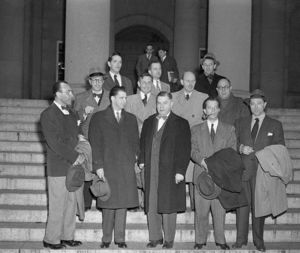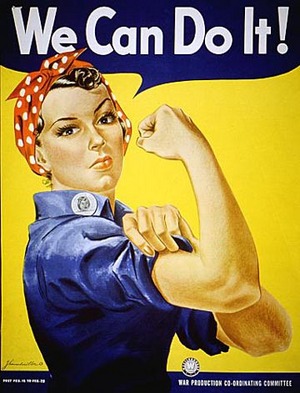Hollywood. 1947. A committee called the House of Un-American Activities Committee (HUAC) was formed to investigate the lives of those involved in the Motion Picture Industry. Actors, writers, producers, directors and crewman were called in to discuss their personal political associations. The fear of Communism invading our country through films delivering messages of propaganda both openly and subliminally made even the most even keeled people paranoid so that this committee believed that by finding people who had either belonged to the Party or knew of those associated with it would help in ridding the “red scare” from this country.
It was a dark and demeaning time for the film industry. If you were called in you were expected to answer the committee’s questions honestly and in full. Questions that were personal. Questions about others. If you didn’t respond, or it was suspected you were being untruthful, you faced blacklisting in the industry or even jail time. Those blacklisted found little to no work. Friends of the past turned their backs for fear even association would bring the blacklist to them.
When all was said and done over 400 industry people were blacklisted. Some of them were able to come back years later while others died, were destroyed or both. Some of the better known people that were blacklisted include Stella Adler, Charles Chaplin, Carl Forman, John Garfield, Howard DaSilva, Dashiell Hammett, Lillian Hellman, Burl Ives, Arthur Miller, Gale Sondergaard, Zero Mostel and director Martin (Hud, Sounder, The Front, Norma Rae, Murphy’s Romance)Ritt.
Some of the people, afraid of jail and the blacklist, who named names, include Elia Kazan, Budd Schulberg, Larry Parks and Lee J. Cobb. Many more were never mentioned publicly by name. Schulberg would go on to write, and Kazan direct, On The Waterfront, which many believe was their answer to those who objected to their actions.
The beginning of the end of the blacklist came in 1960 when director Otto Preminger announced that blacklisted writer Dalton Trumbo would receive credit for his script for Exodus. That same year actor Kirk Douglas hired Trumbo to write the script for Spartacus and revealed it to the press before the film went into production. Soon people began getting hired again and some went on to lucrative careers. Others waited several more years before gainful employment in films was available. By the 1990’s most writers who had used pseudonyms for their work on films had their names rightfully placed back on those films. Sadly this honor would come posthumously for most of them.
For a fairly accurate look at the blacklisting I highly recommend two movies, The Front (1976), starring Woody Allen as a lower class nobody who “fronts” for some writers he knows and becomes famous. In other words, they write the scripts and the front submits them with his name on it and passes on the salary to the writer. This practice was quite common at the height of the blacklisting years. Director Martin Ritt made sure to hire as many blacklisted people as he could both in front of and behind the camera. The ending credits reveal the year they were blacklisted below their name credit. I also recommend 1991’s Guilty By Suspicion starring Robert DeNiro as a film director who finds himself out of work and friends when he is named by another witness as a possible Communist.
This is the story of the Hollywood Ten, as they would become known, and what happened to them because of the blacklist. These 10 men, writers and directors, were among the first to be called to testify. These men had ties to the Communist Party at some point in their life or were members of “left wing” political groups. These ten men refused to testify, refused to name names as the committee was so eager for, sighting their First Amendment rights. HUAC and the appeals courts disagreed and sentenced each man to one year in prison. One year for sighting their rights as any citizen can to use the First Amendment of the Constitution.
With this sentence came the inevitable blacklisting. Each man would go to prison, each was ruined at least for a short time (others longer), and some bounced back….. And one became an informer – a rat.
Here is a look at the 10 men for whom injustice was served. Many of them you may not know by name but you will likely know some of their film credits:
ALVAH BESSIE -Bessie was a novelist who became a screenwriter in the 1940’s. He received an Academy Award nomination for his script for the war hit Objective Burma. He was close friends with actor Lee J. Cobb and the two shared left wing political views. Cobb would name Bessie in his hearing and Bessie was banished from the film industry. Ruined financially by legal fees, Bessie went to his old friend and asked to borrow some money. Cobb refused believing it wouldn’t help. After his imprisonment Bessie moved to Spain for 20 years and wrote a few novels but was never associated with Hollywood again. In the late 1970’s he returned to California where he died quietly in 1985 at the age of 81.
HERBERT J BIBERMAN – Biberman was exclusively a B movie writer, producer and director from the 1930’s until his blacklisting but he was a successful one making low budget films on quick shooting schedules that usually turned a profit. Married to actress Gale Sondergaard (who was also blacklisted), Biberman served six months in prison in 1950 and was unemployable. With his own money Biberman made the 1954 film Salt of the Earth, about deplorable working conditions in New Mexico. Because Biberman was still blacklisted Hollywood ensured that the film was not shown in any U.S. theaters with owners intimidated into believing if they showed Biberman’s film, they would be put on a blacklist by major studios and would not be able to show their movies. Biberman released the film overseas where it garnered great critical response and strong box office results. The film even won top prizes at international film festivals. Eleven years after it was made it was released in the U.S. to great reviews and has since been selected for preservation by the National Film Registry. In 1969 Biberman made his last film, Slaves, which was a return to the B movie form Biberman was used to his whole career. The film was not well received either critically or financially. Biberman died in 1971. His widow was able to return to work after that having been blacklisted for over 20 years.
LESTER COLE – Cole was one of the founders of the Screen Writers Guild and was its President from 1944-45. Cole wrote over 30 scripts, his best known was If I Had A Million starring W.C. Fields. At the time of his blacklisting he was working on a script that would later be completed by John Steinbeck and starred Marlon Brando in Viva Zapata. Cole would serve one year in prison and upon his release fled Hollywood for London. He returned in the late 1950’s and began writing screenplays under a pseudonym. His best known was 1966’s Born Free. In later years he was a film reviewer and screenwriting teacher. He died in 1985 at the age of 81.
EDWARD DMYTRYK – Dmytryk (pronounced Dah-METT-trick) came to Hollywood and began directing films in the mid 30’s. He was steadily employed until the late 40’s making many undistinguishable films. He was sentenced to one year in prison but after having spent a few months in jail, Dmytryk, badly needing money as he went through a divorce, announced he was ready to name names. After his prison release he did testify, named names and was subsequently removed from the blacklist, the only of the Hollywood Ten to do so. He would go on to a mildly distinguished career as a director making such movies as The Caine Mutiny, Broken Lance, The Young Lions, The Carpetbaggers, Mirage, Alvarez Kelly and Shalako. Despite steady employment, Dymtryk was quietly ostracized by fellow filmmakers who never forgave him for talking. In the mid 70’s directing offers dried up so he took to teaching until he retired. He died in 1999.
RING LARDNER, JR. – The son of a famous writer, Lardner came to Hollywood in the 1930’s and was soon working publicity for producer David Selznick. Selznick soon hired Lardner to work as a script doctor, re-writing others scripts without taking credit. By 1940 Lardner was receiving credit for scripts albeit often in collaboration. In 1942 Lardner won his first Academy Award for co-writing Woman Of The Year starring Spencer Tracy and Katherine Hepburn. Lardner would also contribute to the scripts of such films as Laura, Forever Amber and Cloak and Dagger. In 1947 Lardner signed an exclusive contract with 20th Century Fox making him one of the highest paid writers in film and, shortly thereafter, he was called to testify.
When Lardner appeared and was asked if he was “now or ever been a member of the Communist Party,” Lardner responded, “I could answer the question exactly the way you want, but if I did, I would hate myself in the morning.”
Larder was blacklisted and spent one year in prison. When he was released he was only able to find work writing under a pseudonym, which he did for over a decade. In 1965 Lardner was hired to write his first credited script in 16 years, the Steve McQueen classic The Cincinnati Kid. In 1970 Lardner wrote the screen adaptation of the novel M*A*S*H and would win his second Academy Award (he later admitted director Robert Altman went with his trademark improvisational style and little of Larder’s dialogue remained in the finished film), 28 years after his first. In his acceptance speech Lardner told the audience, “I’ll see you in 1998.”
Larder continued to write sporadically in the 70’s working on such films as The Greatest, a biography about and starring Muhammad Ali and Semi-Tough, a football comedy starring Burt Reynolds. Larder was the last surviving member of the Hollywood Ten, dying in 2000 at the age of 85.
JOHN HOWARD LAWSON – Probably the least well known of the “Ten,” Lawson was one of the founders of the Writer’s Guild and was its first President. He was a playwright who evolved into screenwriting and would write such films as Algiers, Blockade, Action in the North Atlantic and Sahara. Lawson was blacklisted, served one year in prison and then exiled himself to Mexico where he wrote scripts such as Cry The Beloved Country and The Careless Years under a pseudonym. He later worked as a professor of film and died in 1977 at the age of 82.
ALBERT MALTZ – Maltz was another transplanted New York playwright who came to Hollywood and had a steady career in the 40’s as a screenwriter. Maltz wrote such films as This Gun For Hire, Destination Tokyo, Pride of the Marines, Broken Arrow and The Naked City. After spending nearly a year in prison, Maltz took to script doctoring though he occasionally wrote a script (most notably The Robe) under a pseudonym. It would be 21 years before Maltz would see his name on a film again with Clint Eastwood’s western Two Mules For Sister Sara, (1970). He would also write Eastwood’s film The Beguiled. Maltz died in 1985 at the age of 76.
SAMUEL ORNITZ – Ornitz was the most outspoken member of “The Ten” and one of the most fervent believers in the “left wing” – at first. Ornitz was a novelist turned screenwriter and, though he is credited with writing well over 30 films, none of them are well remembered today. Ornitz began to alienate even his closest friends by asserting that there was no anti-Semitism in the Soviet Union, a fact he later rescinded when shown the facts. Ornitz had not written a script in over 2 years when he was called before the Committee and subsequently blacklisted and jailed for one year. Upon his release Ornitz could not find work as a screenwriter even under a pseudonym so he returned to writing novels until his death in 1957 at the age of 66.
ADRIAN SCOTT – Scott was the only member of the Ten that was primarily a Producer. He worked with fellow “Ten” member Edward Dmytryk producing such films as Murder My Sweet, Cornered and So Well Remembered. His biggest success came with the first film about anti-Semitism, Crossfire. The film was nominated for 5 Academy Awards including one for Dmytryk (Best Director) and one for Scott (Best Picture). Scott was at the height of his career but it was the last film he would ever produce. Scott would spend one year in prison while Dmytryk would name Scott and accused him of pressuring the director to include Communist propaganda in every film they worked on together. Scott took to writing for television under a pseudonym to make ends meet and would die on Christmas Day, 1973 at the age of 61.
DALTON TRUMBO – Trumbo is likely the most famous and most talented member of “The Ten.” His distinguished screenwriting career began in the 1930’s and blossomed in the 40’s. Some of his scripts include Bill Of Divorcement, Kitty Foyle, I Married A Witch, A Guy Named Joe, and 30 Seconds Over Tokyo. Once he served ten months in prison, Trumbo moved his family to Mexico where he continued writing using a front. Some of his works during this period (for which he would receive proper credit in the 1990’s, some twenty years after his death) included Deadly Is The Female, Roman Holiday (which won the Academy Award), Carnival Story, The Court-Martial of Billy Mitchell, and The Brave One, which would win the Best Original Story Academy Award in 1957. The story was credited to Robert Rich but the award was accepted by a top official of the Writer’s Guild. Suspicious journalists began looking into the background of Rich and when nothing turned up rumors began flying that Trumbo was indeed the writer. It was also about this time, in 1958, when the impropriety of the blacklist came into question and that people working on films deserved proper credit. This notion hit home even further when Pierre Boulle, author of the novel and credited screenwriter of The Bridge on the River Kwai, won the Academy Award for the film even though it was determined that Boulle could not speak or write English and had never met with director David Lean. Blacklisted screenwriters Michael Wilson and Carl Foreman had written the script.
Thanks to Otto Preminger and Kirk Douglas, Trumbo was employable again as a writer and took full advantage of it. His post-blacklist scripts (for which he received credit for at the time) include Lonely Are The Brave, The Sandpiper, Hawaii and The Fixer. In 1971 adapted his 1939 anti-war novel, Johnny Got His Gun, into a script and made his directorial debut. The film was honored at the Cannes Film Festival and lauded by the Hollywood community but the film failed to capture critics or audiences. Many believe the accolades the film received was more professional compensation to its creator for the past instead of to the creation. Trumbo would write only two more scripts after that, Executive Action and Papillon.
That same year the Writer’s Guild honored Trumbo with its lifetime achievement award where he made an impassioned speech that was widely recognized as finally burying the hatchet on both sides. In 1975 Trumbo was finally presented with his Academy Award for The Brave One, written nineteen years earlier. It would be almost twenty years after that when Trumbo was officially given screen credit. In 1993, sixteen years after his death, Trumbo was recognized as the writer of Roman Holiday and his family was presented with the Academy Award.
After Trumbo died in 1976, fellow “Ten” member Ring Lardner, Jr. gave a eulogy that kiddingly poked fun at his dear friend. At rare intervals, there appears among us a person whose virtues are so manifest to all, who has such a capacity for relating to every sort of human being, who so subordinates his own ego drive to the concerns of all others, who lives his life in such harmony with the surrounding community that he is revered and loved by everyone with whom he comes in contact. Such a man Dalton Trumbo was not.”




